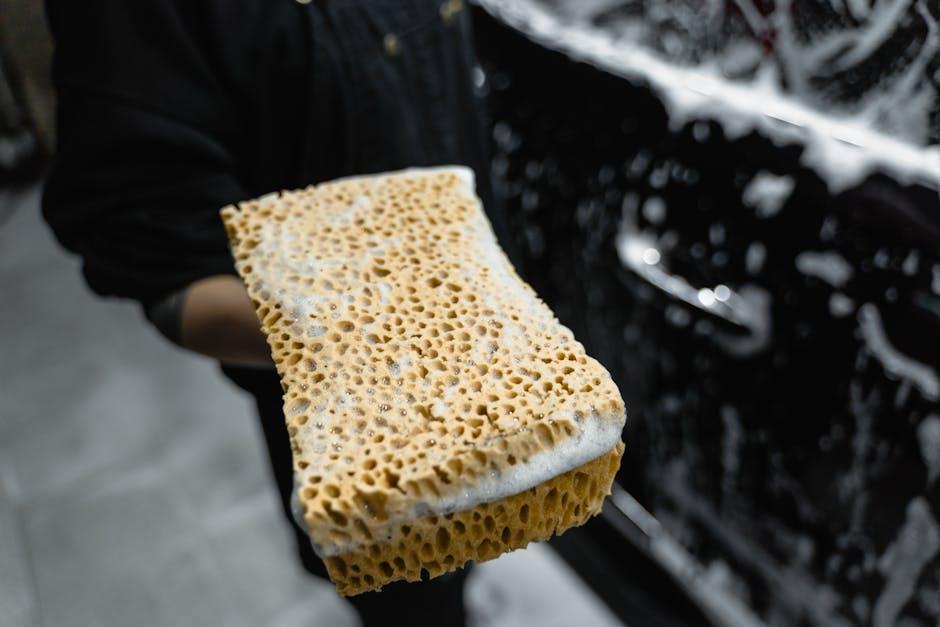Mold in your car is more than just an unwelcome sight—it’s a stealthy intruder that can compromise your health and damage your vehicle’s interior. Often fueled by moisture and neglect, mold spores find the perfect breeding ground in damp upholstery and forgotten spills. While it may seem like an inevitable nuisance in humid climates or after rainy days, preventing mold is entirely within your control. In this article, we’ll explore practical strategies to keep your car fresh, dry, and mold-free, ensuring that every ride feels clean and comfortable.
Table of Contents
- Understanding the Root Causes of Mold Growth in Vehicles
- Effective Moisture Control Techniques for Mold Prevention
- Choosing the Right Cleaning Products for Mold Resistance
- Proper Ventilation Strategies to Keep Your Car Dry
- Routine Maintenance Tips to Avoid Hidden Mold Threats
- Utilizing Technology and Accessories for Mold Detection and Prevention
- Q&A
- The Way Forward

Understanding the Root Causes of Mold Growth in Vehicles
Mold thrives in environments where moisture and warmth intersect, making vehicles a surprisingly vulnerable space. Water intrusion can come from a variety of sources such as leaks in windows, sunroofs, or door seals. Additionally, leaving wet items like umbrellas, clothes, or floor mats inside your car creates a cozy habitat for spores to settle and multiply. Condensation, a common byproduct of temperature fluctuations, especially during colder months, further contributes to increased humidity levels, providing mold with the perfect breeding ground.
Understanding the factors that invite mold helps in targeting prevention efforts effectively. Here are some primary contributors to watch out for:
- Inadequate ventilation: Poor airflow traps moisture, making the interior damp and mold-friendly.
- Spills and stains: Liquids soaked into upholstery or carpets that remain uncleaned promote microbial growth.
- Climate conditions: Areas with high humidity or frequent rain increase the risk of mold if the vehicle isn’t properly cared for.
- Storage habits: Parking in enclosed spaces without proper air circulation creates stagnant, moist air inside the car.
| Source | Common Signs | Action to Take |
|---|---|---|
| Leaky seals | Wet spots on carpets or upholstery | Inspect and replace damaged seals promptly |
| Condensation | Foggy windows or persistent dampness | Use a moisture absorber and improve ventilation |
| Wet belongings | Musty odors after rain | Remove and dry wet items immediately |

Effective Moisture Control Techniques for Mold Prevention
Controlling moisture is the cornerstone of keeping your vehicle’s interior dry and mold-free. Start by regularly airing out your car, especially after rain or snow, by rolling down windows or opening doors in a well-ventilated area. Using high-absorbency mats or replacing carpet linings with moisture-resistant alternatives can create a dry barrier between your footwear and the car’s interior. Additionally, invest in quality moisture absorbers such as silica gel packs or activated charcoal bags strategically placed under seats and in door compartments to trap excess humidity before it can cause issues.
Practical actions for moisture control include:
- Inspect door seals and repair or replace any that are cracked or torn to prevent water leaks.
- Use a portable dehumidifier or automotive air purifier during humid seasons for extra protection.
- Dry wet upholstery or carpets immediately using microfiber towels and a wet/dry vacuum.
| Method | Benefit | Ideal Frequency |
|---|---|---|
| Ventilation | Reduces trapped moisture | After every drive |
| Seal Inspection | Prevents rainwater intrusion | Monthly |
| Use of Absorbers | Maintains dry air | Every 3-6 months |

Choosing the Right Cleaning Products for Mold Resistance
When selecting cleaning products to combat mold, prioritize those that not only clean but also create an inhospitable environment for moisture-loving fungi. Look for formulas containing antimicrobial agents such as tea tree oil, vinegar, or specialized mold inhibitors. Avoid harsh chemicals that can damage your car’s upholstery or dashboard finishes; instead, opt for gentle yet effective solutions designed for automotive interiors.
Consider the following attributes to ensure your cleaning products support long-term mold resistance:
- pH Balanced: Maintains surface integrity while preventing mold growth.
- Quick Drying: Reduces moisture retention—a critical factor for mold.
- Eco-Friendly Ingredients: Safe for you and your vehicle’s materials.
- Surface Compatibility: Effective on leather, fabric, and plastic without discoloration.
| Product Type | Key Features | Best For |
|---|---|---|
| Antimicrobial Spray | Natural oils, quick drying | Dashboards, vents |
| Foaming Upholstery Cleaner | pH balanced, gentle formula | Fabric seats, carpets |
| Leather Conditioner | Prevents cracks, mold resistant | Leather seats, trim |

Proper Ventilation Strategies to Keep Your Car Dry
Maintaining airflow within your vehicle is crucial in combating mold growth caused by trapped moisture. To achieve this, consider leaving your windows slightly cracked when parked in a secure area, allowing humid air to escape and fresh air to circulate. Use your car’s built-in ventilation system strategically; running the air conditioner or heater—even briefly—helps to reduce interior humidity. Additionally, install aftermarket ventilation accessories, like vent shades or deflectors, which enable air exchange without compromising security or weather protection.
Simple habits can reinforce effective moisture management inside your vehicle. Regularly airing out your car by opening doors and windows, especially after wet weather, prevents condensation buildup. Consider the following tips to maintain dry, fresh air:
- Use moisture absorbers: Silica gel packs or activated charcoal bags can trap residual dampness.
- Keep interior fabrics dry: Wipe off wet seats and floor mats promptly to prevent lingering dampness.
- Park in shaded, well-ventilated areas: Reduce heat buildup that encourages moisture accumulation.
- Inspect and replace door seals: Faulty seals allow water ingress disrupting ventilation balance.
| Ventilation Strategy | Benefit |
|---|---|
| Crack Windows Slightly | Facilitates continuous airflow |
| Use AC/Heater Periodically | Reduces humidity inside cabin |
| Install Vent Shades | Allows ventilation while preventing rain |
| Apply Silica Gel Packs | Absorbs excess moisture effectively |

Routine Maintenance Tips to Avoid Hidden Mold Threats
Keep your car’s interior dry and well-ventilated by regularly airing it out, especially after rain or snow. Moisture trapped inside the cabin is a prime breeding ground for mold spores. Open windows or doors for a few minutes when parked in a safe spot, and consider using moisture-absorbing products like silica gel packs or charcoal bags placed strategically under seats and in door pockets. Don’t forget to check and replace cabin air filters periodically, as clogged filters can hold dampness and promote mold growth.
Maintaining cleanliness is equally vital. Make a habit of:
- Wiping down wet surfaces immediately, including floor mats and upholstery.
- Removing trash and damp clothing after trips.
- Vacuuming regularly to eliminate dust and debris that can feed mold.
For cars in humid climates, investing in a dehumidifier designed for vehicles can offer an extra layer of protection. By integrating these simple habits, you safeguard your car’s interior against the unseen but persistent threat of mold.

Utilizing Technology and Accessories for Mold Detection and Prevention
Implementing cutting-edge technology can revolutionize how you detect and manage mold growth in your vehicle. Devices such as moisture meters and thermal imaging cameras allow for precise detection of hidden damp spots where mold tends to thrive, often unnoticed by the naked eye. Pair these tools with smartphone apps designed for air quality monitoring, which can alert you when humidity levels inside your car rise to dangerous levels, prompting timely intervention before mold takes hold.
Beyond detection, utilizing specific accessories not only combats mold but actively prevents it. Consider investing in:
- Portable dehumidifiers tailored for confined spaces like cars
- UV-C light sanitizers that disrupt mold spores and bacteria
- Antimicrobial seat covers that inhibit fungal growth
The table below summarizes these accessories along with their key benefits:
| Accessory | Primary Benefit | Ideal Use |
|---|---|---|
| Portable Dehumidifier | Reduces internal moisture | Long trips, humid climates |
| UV-C Light Sanitizer | Kills mold spores | Periodic cleanings |
| Antimicrobial Seat Covers | Prevents fungal growth | Daily use |
Q&A
Q&A: How to Prevent Mold in Your Car
Q1: Why is mold a common problem in cars?
A1: Mold thrives in warm, damp, and poorly ventilated environments—conditions that your car can easily develop, especially if there’s moisture trapped inside from wet clothes, spills, or humid weather. Without proper care, this creates a perfect breeding ground for mold.
Q2: What are the first signs of mold growing in a car?
A2: You might notice a musty or earthy smell that lingers even after airing out the vehicle. Visually, mold can appear as fuzzy black, green, or white spots on upholstery, carpets, or even inside door seals.
Q3: How can I keep moisture out of my car in the first place?
A3: Start by ensuring windows and sunroofs are closed tight during rain or car washes. Remove wet items like umbrellas, coats, or floor mats promptly. Using silica gel packets or moisture absorbers inside your car can help keep humidity levels low.
Q4: Is ventilation important in preventing mold?
A4: Absolutely. Good airflow dries out damp areas and discourages mold growth. Whenever possible, crack the windows slightly (if safe), and use your vehicle’s air conditioning or heating system to circulate air, especially on colder or rainy days.
Q5: What’s the best way to clean mold if I find it in my car?
A5: For small patches, use a mixture of equal parts water and white vinegar or a dedicated mold cleaner. Wear gloves and a mask to avoid inhaling spores. Gently scrub the affected areas, then dry thoroughly. For extensive mold infestations, professional cleaning is recommended.
Q6: Can regular car maintenance help reduce mold risks?
A6: Yes! Check door and window seals regularly to prevent leaks. Keep your AC system clean and consider running the fan periodically to avoid moisture buildup in the ducts. Also, promptly fix any leaks from the sunroof, windshield, or heater core.
Q7: Are there any preventative products specifically made for cars?
A7: Several products, like mold-resistant sprays, moisture absorbers, and antibacterial interior cleaners, are designed specifically for vehicles. Using these can add an extra layer of protection, especially if you live in a humid climate.
Q8: How often should I inspect my car for mold risks?
A8: Make mold prevention part of your regular car care routine. Inspect your car monthly, especially after rainy periods or if you notice a musty smell. Early detection helps stop mold before it gains a foothold.
Preventing mold in your car isn’t just about keeping it smelling fresh—it protects your health and preserves the vehicle’s interior. With a bit of mindfulness and routine care, you can keep your ride mold-free and comfortable year-round.
The Way Forward
Keeping your car mold-free is more than just a matter of cleanliness—it’s about preserving your vehicle’s health and your own well-being. By staying vigilant and adopting simple habits like controlling moisture, ensuring proper ventilation, and regular cleaning, you create an environment where mold simply won’t thrive. Remember, a dry car is a happy car, and with these prevention tips, you can enjoy a fresh, comfortable ride every time you hit the road. Safe travels and breathe easy!

